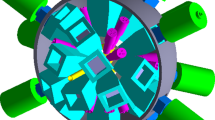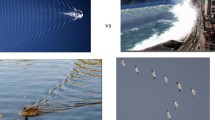Abstract
A mechanism of triggering the 12.7keV E3 transition, based on the new decay mode of the 31y isomer via resonance internal conversion and emission of a 1.4keV X-ray quantum, is considered. Actually, this decay mode was observed previously in the decay of 45- and 46-fold ions of 125Te . For the purpose of triggering, the atomic radiative vertex has to be induced by resonance radiation. This mechanism makes triggering by an order of magnitude more efficient than triggering a bare nucleus, and is achieved at a lower combination frequency. An experiment is proposed for the direct observation of the new decay mode. This also offers a new way of resonance scattering of these X-rays. Triggering through higher-lying 2573 and 2805keV states is also considered. The results are extended to the general problem of triggering. The main obstacle for enhancing the efficiency is a high internal conversion rate. For this reason, shape isomers with low multipole order --E1 , M1 , and with a high enough energy of triggering transition are of interest for triggering. The partial ionization of the outer electrons will also help. The same recommendations hold for triggering isomers in laser-produced plasma.
Similar content being viewed by others
References
C.B. Collins, F. Davanloo, A.C. Rusu, Phys. Rev. C 61, 054305 (2000).
C.B. Collins, N.C. Zoita, A.C. Rusu, Europhys. Lett. 57, 677 (2002).
F.J. Agee, A.Y. Maitsuura, in Isomers and Quantum Nucleonics (JINR, Dubna, 2006) p. 9.
I. Bikit, I.V. Anicin, M. Krmar, J. Phys. G: Nucl. Part. Phys. 19, 1359 (1993).
C.B. Collins, J.J. Carroll, T.W. Sinor, M.J. Byrd, D.G. Richmond, K.N. Taylor, Phys. Rev. C 42, R1813 (1990).
I. Bikit, L. Lakosi, J. Safar, L. Concic, Astrophys. J. 522, 419 (1999).
I. Ahmad, J.C. Banar, J.A. Becker, Phys. Rev. Lett. 87, 072503 (2001)
S.M. Mullins, G.D. Dracoulis, A.P. Byrne, T.R. McGoram, S. Bayer, W.A. Seale, F.G. Kondev, Phys. Lett. B 393, 279 (1997).
N.K. Kuzmenko, V.M. Mikhailov, V.O. Nesterenko, Izv. Akad. Nauk, Ser. Fiz. 50, 1914 (1986).
Yang Sun, Xian-Rong Zhou, Gui-Lu Long, Phys. Lett. B 589, 83 (2004).
V.G. Soloviev, Theory of Complex Nuclei (Pergamon, Oxford, 1976).
S.A. Karamian, J.J. Carroll, S. Iliev, S.P. Tretyakova, Phys. Rev. C 75, 057301 (2007).
F.R. Xu, P.M. Walker, R. Wyss, Phys. Rev. C 62, 014301 (2000).
F.F. Karpeshin, I.M. Band, M.B. Trzhaskovskaya, Nucl. Phys. A 654, 579 (1999).
B.A. Zon, F.F. Karpeshin, Zh. Exp. Teor. Fiz. 97, 401 (1990) (Sov. Phys. JETP (USA) 70, 224 (1990)).
F.F. Karpeshin, Hyperfine Interact. 143, 79 (2002).
F.F. Karpeshin, Part. Nucl. 37, 284 (2006).
F.F. Karpeshin, Propmpt Fission in Muonic Atoms (Nauka, St. Petersburg, 2006).
D.F. Zaretsky, F.F. Karpeshin, Sov. J. Nucl. Phys. 29, 306 (1979).
F.F. Karpeshin, M.R. Harston, F. Attallah, Phys. Rev. C 53, 1640 (1996).
F. Attallah, M. Aiche, J.F. Chemin, Phys. Rev. C 55, 1665 (1997).
T. Carreyre, M.R. Harston, M. Aiche, Phys. Rev. C 62, 024311 (2000).
M.R. Harston, T. Carreyre, J.F. Chemin, F.F. Karpeshin, M.B. Trzhaskovskaya, Nucl. Phys. A 676, 143 (2000).
F.F. Karpeshin, M.B. Trzhaskovskaya, Phys. At. Nucl. 71, 1383 (2008).
F.F. Karpeshin, M.B. Trzhaskovskaya, Phys. Rev. C 76, 054313 (2007).
F.F. Karpeshin, I.M. Band, M.B. Trzhaskovskaya, M.A. Listengarten, Phys. Lett. B 372, 1 (1996).
I.M. Band, M.B. Trzhaskovskaya, C.W. Nestor jr., P.O. Tikkanen, S. Raman, At. Data Nucl. Data Tables 81, 1 (2002).
S. Kishimoto, Y. Yoda, Y. Kobayashi, Phys. Rev. C 74, 031301(R) (2006).
V.B. Berestetsky, E.M. Lifshitz, L.P. Pitaevsky, Relativistic Quantum Theory, part 1 (Nauka, Moscow, 1969).
O. Bohr, B. Mottelson, Nuclear Structure, Vols. I and II (W.A. Benjamin Inc., N.-Y., Amsterdam, 1969).
R.B. Firestone, Table of Isotopes, 8th ed. (LBNL, University of California, 1998).
A.B. Hayes, D. Cline, C.Y. Wu, Phys. Rev. Lett. 89, 242501 (2002).
F.F. Karpeshin, Yu.N. Novikov, M.B. Trzhaskovskaya, Yad. Fiz. 67, 234 (2004) (Phys. At. Nucl. (USA) 67, 217 (2004)).
I.N. Izosimov, JINR E6-2006-109
V.I. Goldansky, V.S. Letokhov, Zh. Exp. Teor. Fiz. 67, 513 (1967) (Sov. Phys. JETP 40, 254 (1974)).
B.A. Zon, V.E. Chernov, Phys. Lett. B 383, 367 (1996).
Author information
Authors and Affiliations
Corresponding author
Additional information
W. Nazarewicz
Rights and permissions
About this article
Cite this article
Karpeshin, F.F., Trzhaskovskaya, M.B. & Zhang, J. Prospect of triggering the 178m2Hf isomer and the role of resonance conversion. Eur. Phys. J. A 39, 341–348 (2009). https://doi.org/10.1140/epja/i2008-10714-3
Received:
Revised:
Accepted:
Published:
Issue Date:
DOI: https://doi.org/10.1140/epja/i2008-10714-3




